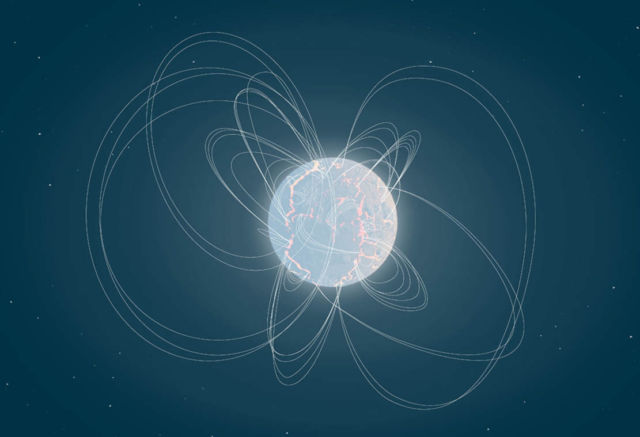Born from an exploded star, the infant magnetar belongs to a family of extreme objects called neutron stars. Its discovery may lend insight into these strange phenomena.
Astronomers tend to have a slightly different sense of time than the rest of us. They regularly study events that happened millions or billions of years ago, and objects that have been around for just as long. That’s partly why the recently discovered neutron star known as Swift J1818.0-1607 is remarkable: A new study in the journal Astrophysical Journal Letters estimates that it is only about 240 years old – a veritable newborn by cosmic standards.
Above: This illustration shows magnetic field lines protruding from a highly magnetic neutron star, or a dense nugget left over after a star goes supernova and explodes. Known as magnetars, these objects generate bright bursts of light that might be powered by their strong magnetic fields. Credit: ESA
NASA’s Neil Gehrels Swift Observatory spotted the young object on March 12, when it released a massive burst of X-rays. Follow-up studies by the European Space Agency’s XMM-Newton observatory and NASA’s NuSTAR telescope, which is led by Caltech and managed by the agency’s Jet Propulsion Laboratory, revealed more of the neutron star’s physical characteristics, including those used to estimate its age.
A neutron star is an incredibly dense nugget of stellar material left over after a massive star goes supernova and explodes. In fact, they’re some of the densest objects in the universe (second only to black holes): A teaspoon of neutron star material would weigh 4 billion tons on Earth. The atoms inside a neutron star are smashed together so tightly, they behave in ways not found anywhere else. Swift J1818.0-1607 packs twice the mass of our Sun into a volume more than one trillion times smaller.
With a magnetic field up to 1,000 times stronger than a typical neutron star – and about 100 million times stronger than the most powerful magnets made by humans – Swift J1818.0-1607 belongs to a special class of objects called magnetars, which are the most magnetic objects in the universe. And it appears to be the youngest magnetar ever discovered. If its age is confirmed, that means light from the stellar explosion that formed it would have reached Earth around the time that George Washington became the first president of the United States.
“This object is showing us an earlier time in a magnetar’s life than we’ve ever seen before, very shortly after its formation,” said Nanda Rea, a researcher at the Institute of Space Sciences in Barcelona and principal investigator on the observation campaigns by XMM Newton and NuSTAR (short for Nuclear Spectroscopic Telescope Array).
source JPL NASA






Leave A Comment